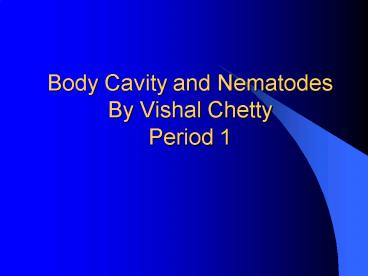Body Cavity and Nematodes By Vishal Chetty Period 1 - PowerPoint PPT Presentation
1 / 17
Title:
Body Cavity and Nematodes By Vishal Chetty Period 1
Description:
They have longitudinal muscles and so when the muscle contracts it creates a thrashing movement. ... Trichinella is a parasite of man pig and other mammals. ... – PowerPoint PPT presentation
Number of Views:107
Avg rating:3.0/5.0
Title: Body Cavity and Nematodes By Vishal Chetty Period 1
1
Body Cavity and NematodesBy Vishal ChettyPeriod
1
2
Body Cavity
- The three main internal body plans are
- Symmetry- Radial symmetry, Bilateral symmetry.
- Tissues- Animals body plans vary in regard to the
organization of the animals tissue. True tissues
are specialized cells that are stores away from
other tissues by membranous layers. - Body Cavities- A fluid filled space separatingthe
digestive tract fro the outer body wall.
3
The layers
- Symmetry- Dorsal (top), ventral (bottom),
Anterior (head), posterior (tail). - Tissues- Germ layers Form the various tissues
and organs of the body. - Ectoderm the germ layer covering the surface of
the embryo, develops the outer covering of the
animal and some phyla. - Endoderm- the innermost germ layer, it lines the
growing digestive tube, which is also called
archenteron. It further lines the digestive tract
and also the organs that are connected with the
digestive tract. - Animals that have these 2 germ layers are called
diploblastic. Ex. Cnidaries like coral. - There is a THIRD germ layer! The mesoderm forms
the muscles and most other organs between the
digestive tube and the outer covering of the
animal. This type is called triploblastic meaning
three germ layers.
4
Layers Contd
- Body Cavities- Coelom forms from tissue that came
from the mesoderm. The internal organs are
suspended by the inner and outer tissue that
surround the cavity dorsally and ventrally. - Pseudocoeloates- formed from blastocoel not
mesoderm - Acoelomates- lacking a coelom.
5
Advantages and Disadvantages
- Radial symmetrical animals are shaped in the form
of a cylinder and they tend to be slow moving,
but they have arms that extend 360 degrees so
they can respond to food or to predators. - Bilateral Symmetry- all 5 senses are in the front
of the head so therefore it can react and make
decisions. - Tissues- Diploblastic are the first animals to
have true tissues endoderm and ectoderm, which
shows specialization. - Triploblastic is 3 tissue layers and allowed the
formation of organs and organ system and coeloms.
- Advantage of a coelom is that a coelom is a fluid
filled body cavity that allows organs to be free
moving, they can grow larger, because they are
hanging freely in the cavity. The fluid protects
them from shock and injury.
6
http//www.nhc.ed.ac.uk/images/collections/inverte
brates/intros/LgCoelom.jpg
7
Nematodes
http//www.nematology.umd.edu/images/eis160.jpg
8
Introduction
- How are roundworms different from flatworms?
- Through symmetry, specializations (body
structure), digestion and reproduction/life cycle
we will understand the differences of roundworms
and flatworms.
9
The Nematode!
- Round Worms are known as nematodes
- They are the most common phyla animal with over
20,000 different species - They are found in freshwater, marine, and
terrestrial environments. - They are decomposers, but parasitic of humans.
- If you pick up a handful of soil there will be
thousands of nematodes in that soil. - They feed off bacteria, fungi and other
nematodes.
Flatworms!
- Free living turbellarians, parasitic flukes,
which live in the liver and parasitic tapeworms
10
Symmetry
- Both flatworms and roundworms have bilateral
symmetry meaning they have an anterior, posterior
end - Flatworms are acoelomate, which means they have
no body cavity - Roundworms are pseudocoelomate, which means they
dont have a true body cavity that is lined
completely with mesoderm, rather one side is.
Mesoderm is a embryonic layer.
11
Specialization
- The nematode have cuticles, which is a thick
outer covering that prevents dehydration and
gives them a shape. - They have longitudinal muscles and so when the
muscle contracts it creates a thrashing movement. - They range from 0.3mm to 8 meters in size.
- Flatworms do not have cuticles, because they live
in an aquatic environment or inside a host. - Flatworms are flat and gives a rapid diffusion of
nutrients and waste. This is an advantage.
12
http//www.ustboniface.mb.ca/cusb/abernier/Animaux
/Pseudocoelom/nematode.GIF
13
Digestion
- The nematode is the first animal to have a
complete digestive tract. - The flatworms dont have a digestive tract, but
they have a gastrovascular cavity, which is where
there is only one opening with a branched
digestive sack.
http//kentsimmons.uwinnipeg.ca/16cm05/16labman05/
lb5pg5_files/flatworm2.jpg
14
Reproduction
- Nematodes have separate sexes internal
fertilization. They release millions of eggs
inside their host or into the soil. - Tapeworms are hermaphrodites, which means that
they have both sexes
15
Interesting Fact
- Trichinella is a parasite of man pig and other
mammals. It has an interesting life cycle because
it has no stages outside the host.
16
Story Time!
17
Bibliography
- Campbell, Neil A., Reece, Jane B. Biology Seventh
Edition. Pearson Benjamin Cummings. San Francisco































